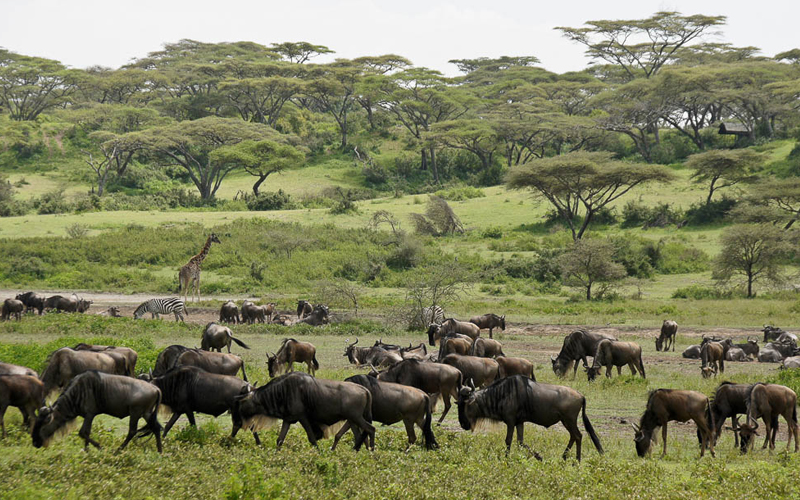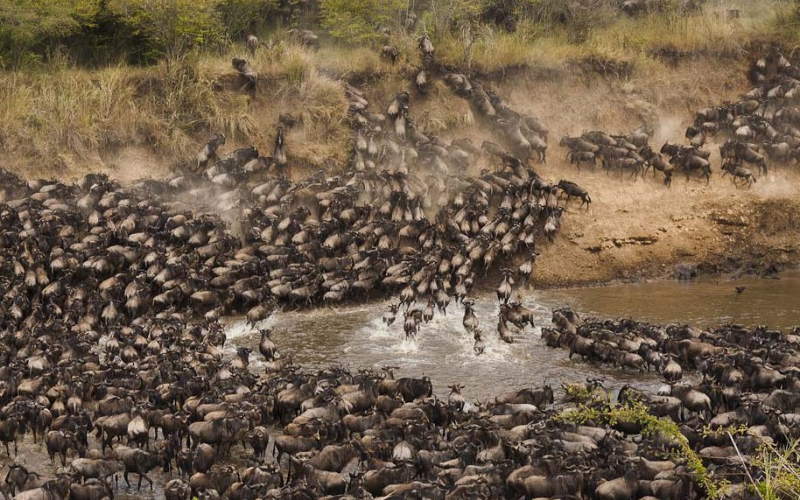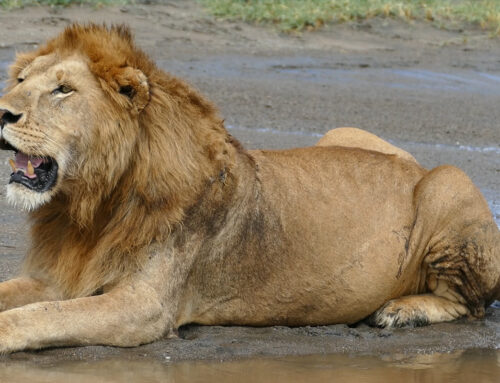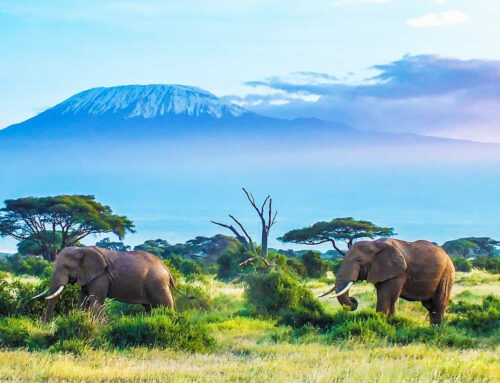The Great Migration is one of the most spectacular wildlife events on the planet, involving millions of wildebeest, zebras, and gazelles traversing the Serengeti-Mara ecosystem in search of fresh grazing grounds and water. Understanding the timing and movement of this migration can enhance your safari experience, offering opportunities to witness breathtaking scenes of nature in action. Here’s a detailed month-by-month guide for 2024 to help you plan your trip and catch the migration at its peak.
The Great Migration in 2024
January: The Start of the Journey
- Calving Season: In January, the Great Migration is primarily focused on the southern Serengeti plains in Tanzania. This period marks the beginning of the calving season, with thousands of wildebeest giving birth to their young. The southern Serengeti is a critical area for calving due to its nutrient-rich grasses. Visitors in January can witness the dramatic and heartwarming scenes of newborn calves struggling to stand and take their first steps.
- Wildlife Watching Tips: This is an excellent time for game viewing as predators are also on the hunt for the vulnerable young calves. Expect to see numerous lion pride, cheetahs, and hyenas taking advantage of the calving season.
February: Peak Calving and Predator Action
- High Concentration of Wildlife: February is arguably one of the best months to visit the southern Serengeti. The calving season is in full swing, and the sheer number of wildebeest, zebra, and gazelles provides incredible wildlife viewing. With over 500,000 wildebeest calves being born, the plains are teeming with activity. This also attracts a high concentration of predators, making for some thrilling and dramatic encounters.
- Photography Opportunities: The abundance of young wildlife against the backdrop of the expansive Serengeti plains offers fantastic photographic opportunities. Capture the intensity of predator-prey interactions and the tender moments between mothers and their calves.
March: Transition to the Western Corridor
- Migration Movement: As March progresses, the wildebeest and their fellow travelers begin to move westward toward the Western Corridor. The lush grasslands of the southern Serengeti start to dry out, prompting the herds to migrate in search of greener pastures. The Western Corridor is known for its dramatic scenery, including the Grumeti River, which poses a significant challenge for the migrating herds.
- Wildlife Viewing Tips: Prepare for exciting river crossings as the herds attempt to navigate the treacherous waters of the Grumeti River. This period offers a unique chance to witness these dramatic and often perilous crossings, which are crucial for the survival of the herds.
April: Rainy Season Begins
- River Crossings and Rainfall: April is the start of the rainy season in the Serengeti, bringing heavy rains that transform the landscape. The Western Corridor becomes lush and green, providing ample grazing opportunities for the migrating herds. This is also a time of significant river crossings, with the Grumeti River being a key challenge for migrating animals.
- Safari Considerations: The rains can make roads muddy and difficult to navigate, so prepare for variable safari conditions. However, the lush landscape and reduced tourist numbers can offer a more serene and intimate wildlife experience.
May: The Migration Moves North
- Entering the Northern Serengeti: By May, the Great Migration continues its journey towards the northern Serengeti and the border with Kenya. The herds are often seen moving through the Loliondo and northern Serengeti regions, where the lush vegetation supports their continued journey. The migration’s movement is dictated by the search for the best grazing grounds and water sources.
- Wildlife Watching Tips: Look out for the herds making their way through scenic landscapes, including the rocky outcrops and woodlands of the northern Serengeti. The changing scenery provides a fresh perspective on the migration and its challenges.
June: River Crossings in the Northern Serengeti
- Crossing the Mara River: June marks the beginning of the most dramatic phase of the Great Migration: the crossing of the Mara River into Kenya. This event is one of the most iconic and thrilling moments of the migration, as the herds face the perilous task of crossing the crocodile-infested waters of the Mara River. The sheer scale and intensity of these crossings are a highlight for many safari-goers.
- Best Viewing Spots: For optimal viewing of the Mara River crossings, consider staying in the northern Serengeti or crossing into Kenya’s Maasai Mara. Both locations offer prime vantage points for witnessing this epic event.
July: Peak Migration and River Crossings
- High Drama on the Mara River: July continues the peak of the Mara River crossings. The herds are often concentrated in the northern Serengeti and Maasai Mara, making this a prime time to witness the migration’s dramatic river crossings. The river crossings are characterized by large numbers of animals attempting to cross at once, creating a chaotic and thrilling spectacle.
- Safari Tips: Due to the high volume of visitors and the intense activity at the river, it’s advisable to plan your safari early and book accommodations in advance. Guided safaris and expert guides can enhance your experience by providing insights and ensuring the best viewing spots.
August: The Migration in the Maasai Mara
- Exploring the Maasai Mara: In August, the Great Migration is typically centered in Kenya’s Maasai Mara. The herds have crossed into the Maasai Mara, where they continue to graze and move through the reserve. The Mara River crossings are still ongoing, and the lush grasslands provide a beautiful backdrop for the migration.
- Wildlife Viewing: August offers fantastic wildlife viewing opportunities, including not only the Great Migration but also the diverse wildlife of the Maasai Mara. Expect to see large herds of wildebeest, zebra, and gazelle, as well as predators such as lions, cheetahs, and hyenas.
September: Peak Migration in the Maasai Mara
- Migration Highlights: September is one of the best months for witnessing the Great Migration in the Maasai Mara. The herds are still present in the Mara, and the river crossings are often at their peak. The abundance of wildlife and the dramatic river crossings make September a popular time for safari enthusiasts.
- Photography and Sightseeing: This is an ideal time for capturing stunning photographs of the migration and the surrounding landscapes. The clear skies and vibrant scenery provide excellent conditions for wildlife photography.
October: Departure from the Maasai Mara
- Migration Moves South: By October, the herds begin their journey back south toward the Serengeti. The Maasai Mara sees a reduction in the number of migrating animals as they move southward in search of food and water. This transition period marks the end of the high drama of the river crossings.
- Safari Considerations: As the herds move south, focus on the remaining groups and their movement patterns. This is also a good time to explore other areas of the Maasai Mara and enjoy the general wildlife experience.
November: Return to the Serengeti
- Migration in the Serengeti: In November, the herds start to re-enter the southern Serengeti, where they return to the calving grounds. The landscape becomes green again with the onset of the short rains, providing fresh grazing opportunities for the returning herds.
- Wildlife Watching: The Serengeti’s southern plains are once again filled with wildebeest, zebras, and gazelles. The return to the calving grounds is a quieter period but still offers excellent wildlife viewing opportunities.
December: Preparing for the Next Cycle
- End of the Migration Cycle: By December, the Great Migration is winding down as the herds are spread out across the southern Serengeti. The calving season will soon begin again, marking the start of a new cycle. The plains are lush and green, offering a peaceful end to the year’s migration.
- Safari Tips: This is a good time for a quieter safari experience. The landscape is vibrant and the wildlife remains active, providing a more relaxed atmosphere for viewing.
Understanding the Great Migration’s month-by-month movements in 2024 can help you plan a safari that aligns with your interests and preferences. Whether you’re eager to witness the dramatic river crossings, the calving season, or the serene landscapes of the southern Serengeti, each month offers a unique perspective on this incredible wildlife phenomenon.
FAQs
1. What is the best month to witness the Mara River crossings?
The best months for Mara River crossings are June and July when the herds are typically at their peak in the northern Serengeti and Maasai Mara.
2. Can I see the Great Migration in Kenya?
Yes, Kenya’s Maasai Mara is a prime location for witnessing the Great Migration, especially from July to September when the herds are in the region.
3. How can I book a safari to see the Great Migration?
Booking a safari with a reputable tour operator who specializes in migration tours can enhance your experience. Early booking is recommended to secure accommodations and guides.
4. Are there specific lodges or camps that offer the best views of the migration?
Yes, several lodges and camps in both the Serengeti and Maasai Mara are strategically located to offer prime viewing of the migration. Researching and booking these accommodations can maximize your experience.
5. What should I bring on a safari to see the Great Migration?
Bring binoculars, a good camera with a zoom lens, and appropriate safari clothing. Prepare for varying weather conditions and ensure you have all necessary travel documents and permits.
For an extraordinary Tanzanian adventure, explore the following highlights on our site:
- Kilimanjaro Climbing
- Ruaha National Park
- Selous Game Reserve
- Serengeti National Park
- Tanzania Safari Packages
- Zanzibar Beach Tours
Visit our page for detailed information and tips to plan your perfect Tanzanian journey.








Leave A Comment